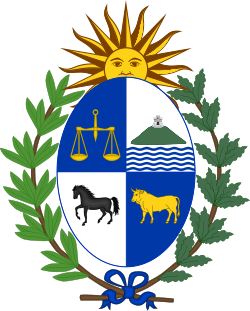Fructuoso Rivera
José Fructuoso Rivera y Toscana (17 October 1784 – 13 January 1854) was a Uruguayan general and patriot who fought for the liberation of Banda Oriental from Brazilian rule, twice served as Uruguay's President and was one of the instigators of the long Uruguayan Civil War. He is also considered to be the founder of the Colorado Party, which ruled Uruguay without interruption from 1865 until 1958. He made a controversial decision to almost completely eliminate the native Charrúa during the 1831 Massacre of Salsipuedes.
Fructuoso Rivera | |
|---|---|
 | |
| 1st President of Uruguay | |
| In office 6 November 1830 – 24 October 1834 | |
| Preceded by | Luis Eduardo Pérez |
| Succeeded by | Carlos Anaya |
| Personal details | |
| Born | 17 October 1784 Durazno, Uruguay |
| Died | 13 January 1854 (aged 69) Melo, Uruguay |
| Nationality | Uruguayan |
| Political party | Colorado Party |
| Profession | Military |
Life
Rivera was a rancher who joined the army of José Gervasio Artigas in 1810. Eventually he rose to the rank of general. When Banda Oriental was occupied by Portuguese and the defeated Artigas forced into exile in 1820, Rivera stayed in the newly created Cisplatina province.
When in 1825 the Thirty-Three Orientals led by Juan Lavalleja and their Argentine supporters, began their fight against the Empire of Brazil, Rivera joined the Argentinians. It's not clear if he joined voluntarily or was forced to join. He soon became important military commander during the Cisplatine War and participated in the Battle of Rincón and Battle of Sarandí. Due to arguments with other leaders, Rivera left the country for a year and did not participate in the Battle of Ituzaingó in 1827.
After Uruguayan independence was proclaimed in 1828, arguments between Rivera and Lavalleja turned into fighting, and Argentine general José Rondeau became the first provisional Governor. Rivera finally assumed Presidency for a term from 6 November 1830 until 24 October 1834. Rivera then supported General Manuel Oribe as his successor to Presidency. Once again, Rivera become involved in conflict with Lavalleja and also with Oribe. In October 1838 Rivera defeated Oribe and forced him to flee into exile to Buenos Aires. During this conflict the political division between Colorados and Blancos began, as Rivera's supporters wore red armbands, but Oribe's wore white. Later these factions form their political parties. Rivera assumes Presidency for the second time between 1 March 1839 and 1 March 1843.
Oribe, with the support of Buenos Aires strongman Juan Manuel de Rosas, organized a new army and invaded Uruguay, thus starting the Uruguayan Civil War. In December 1842 Oribe defeated Rivera at the Battle of Arroyo Grande and started the Great Siege of Montevideo. Rivera's power was limited to the capital city, while Oribe ruled the rest of the country. In 1847 Rivera was forced to leave for exile in Brazil, where he stayed until 1853.
After President Juan Francisco Giró was overthrown, a ruling triumvirate was created on 25 September 1853 consisting of Venancio Flores, Juan Antonio Lavalleja and Rivera. However, Lavalleja died on 22 October and Rivera died on 13 January 1854 en route to Montevideo, leaving only Flores in power.[1]
Later legacy
Rivera's legacy in Uruguayan political history, and particularly among the members of the Colorado Party, is one of strong personal leadership. A 'Riverista' tendency (among others, represented by Jorge Pacheco Areco and the Bordaberry family) in the Colorado Party has long existed as a counterpoint to the 'Batllista' and other factions.
See also
| Political offices | ||
|---|---|---|
| Preceded by Luis Eduardo Pérez (interim) |
President of Uruguay 1830 – 1834 |
Succeeded by Carlos Anaya |
| Preceded by Gabriel Antonio Pereira (interim) |
President of Uruguay 1838 – 1839 |
Succeeded by Gabriel Antonio Pereira |
| Preceded by Gabriel Antonio Pereira (interim) |
President of Uruguay 1839 – 1843 |
Succeeded by Joaquín Suárez de Rondelo |
| Preceded by Juan Francisco Giró |
President of Uruguay 1853 - 1854 |
Succeeded by Venancio Flores |
Bibliography
- Setembrino Pereda, La leyenda del arroyo Monzón, Lavalleja y Rivera. Montevideo: 1935.
